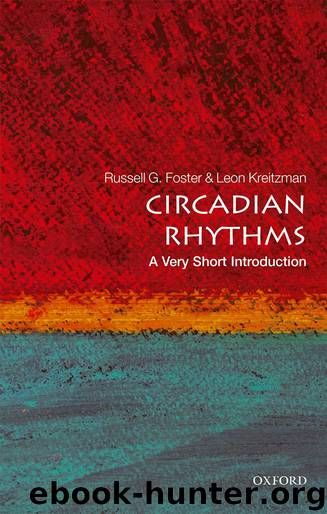Circadian Rhythms: A Very Short Introduction by Russell Foster & Leon Kreitzman

Author:Russell Foster & Leon Kreitzman
Language: eng
Format: epub
ISBN: 9780191027475
Publisher: OUP Oxford
Published: 2016-12-31T05:00:00+00:00
The concept was prescient but there were problems in the details. The PER molecule lacked the bHLH sequence motif that would enable it to bind directly to the DNA promoter region and hence function as an inhibitory transcriptional regulator—inhibiting its own transcription. The model was stuck until Young discovered another clock gene, the timeless gene (tim) in Drosophila in 1994. Tim mRNA was shown to cycle at about the same time as per, and critically TIM and PER protein were shown to bind together to form a complex. But as neither PER nor TIM nor the PER-TIM dimer bind to DNA, how could they regulate their own genes? The answer to this puzzle and how to close the feedback loop came in 1998. Using mutagenesis, Hall and Rosbash identified two mutants which were arrhythmic, one called Clockjrk and the other, cycle0. The corresponding proteins, CLOCK and CYCLE, encoded bHLH regions that could bind per and tim DNA. In addition they both had a domain called PAS which allowed them to bind together as the CLOCK-CYCLE dimer. PER also had a PAS domain, and so now, one could see how the PER-TIM dimer might regulate the CLOCK-CYCLE dimer through the mutually shared PAS domains. Thus CLOCK-CYCLE are the transcription factors that activate the per and tim genes, and PER and TIM are the negative autoregulators which interact with CLOCK-CYCLE via the PAS region. The door was open to develop the current description of the Drosophila molecular clock which is shown in detail in Figure 13. At first sight the diagram is daunting, and if you are not interested in the details skip Figure 13 and the accompanying description, but it is worth making the effort as this is one of the great achievements in understanding how the interaction of genes and their protein products can ultimately give rise to physiology and behaviour.
13. Outline of the current working model of the circadian molecular clockwork of the fruit fly Drosophila. There are three transcriptional–translational feedback loops with multiple steps that allow the generation of a stable near 24-hour circadian oscillation.
Download
This site does not store any files on its server. We only index and link to content provided by other sites. Please contact the content providers to delete copyright contents if any and email us, we'll remove relevant links or contents immediately.
Sapiens: A Brief History of Humankind by Yuval Noah Harari(14321)
Sapiens by Yuval Noah Harari(5324)
Pale Blue Dot by Carl Sagan(4956)
Homo Deus: A Brief History of Tomorrow by Yuval Noah Harari(4872)
Livewired by David Eagleman(3730)
Origin Story: A Big History of Everything by David Christian(3666)
Brief Answers to the Big Questions by Stephen Hawking(3393)
Inferior by Angela Saini(3294)
Origin Story by David Christian(3170)
Signature in the Cell: DNA and the Evidence for Intelligent Design by Stephen C. Meyer(3099)
The Gene: An Intimate History by Siddhartha Mukherjee(3075)
The Evolution of Beauty by Richard O. Prum(2964)
Aliens by Jim Al-Khalili(2803)
How The Mind Works by Steven Pinker(2777)
A Short History of Nearly Everything by Bryson Bill(2662)
Sex at Dawn: The Prehistoric Origins of Modern Sexuality by Ryan Christopher(2500)
From Bacteria to Bach and Back by Daniel C. Dennett(2462)
Endless Forms Most Beautiful by Sean B. Carroll(2443)
Who We Are and How We Got Here by David Reich(2418)
